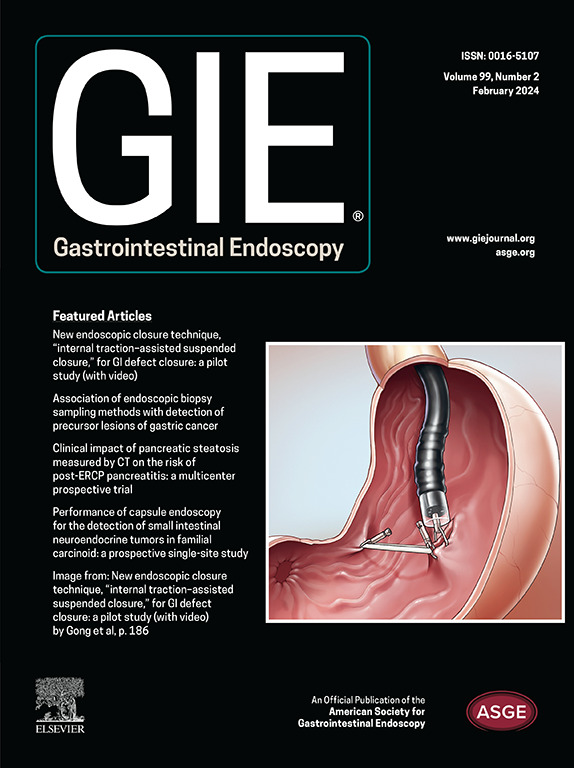基于深度学习的线性内窥镜超声实时图像报告系统。
IF 7.5
1区 医学
Q1 GASTROENTEROLOGY & HEPATOLOGY
引用次数: 0
摘要
背景和目的:图像采集的完整性对于胆胰内镜超声检查(EUS)报告至关重要,会严重影响 EUS 检查的质量和与疾病相关的决策。然而,不同内镜医师的 EUS 报告质量参差不齐。为此,我们开发了基于深度学习的 EUS 自动图像报告系统(EUS-AIRS),旨在实现 EUS 过程中的实时自动拍照记录,包括捕捉标准站、病变和穿刺过程:我们使用 235,784 张图像训练和测试了八个深度学习模型,并将其整合到 EUS-AIRS 中。我们从回顾性测试(包括内部和外部测试)和前瞻性测试两个层面,通过人机对比测试 EUS-AIRS 的性能。自 2023 年 5 月至 2023 年 10 月,我们连续招募了 114 名在武汉大学人民医院接受 EUS 的患者进行前瞻性测试。主要结果是 EUS-AIRS 采集标准站的完整性:结果:就捕获胆胰标准站的完整性而言,EUS-AIRS超过了回顾性内镜检查中各级内镜医师的能力(90.8% [95%CI 88.7%-92.9%] vs. 70.5% [95%CI 67.2%-73.8%], p结论:EUS-AIRS 在实时捕捉高质量、高完整性胆胰 EUS 图像方面表现出卓越的能力,展示了在 EUS 领域应用人工智能图像报告系统的潜力。本文章由计算机程序翻译,如有差异,请以英文原文为准。
A deep learning–based, real-time image report system for linear EUS
Background and Aims
The integrity of image acquisition is critical for biliopancreatic EUS reporting, significantly affecting the quality of EUS examinations and disease-related decision-making. However, the quality of EUS reports varies among endoscopists. To address this issue, we developed a deep learning–based EUS automatic image report system (EUS-AIRS), aiming to achieve automatic photodocumentation in real-time during EUS, including capturing standard stations, lesions, and puncture procedures.
Methods
Eight deep learning models trained and tested using 235,784 images were integrated to construct the EUS-AIRS. The performance of EUS-AIRS was tested through man–machine comparisons at 2 levels: a retrospective test (include internal and external testing) and a prospective test. From May 2023 to October 2023, a total of 114 patients undergoing EUS at Renmin Hospital of Wuhan University were consecutively recruited for prospective testing. The primary outcome was the completeness of the EUS-AIRS for capturing standard stations.
Results
In terms of completeness in capturing biliopancreatic standard stations, EUS-AIRS exceeded the capabilities of endoscopists at all levels of expertise in retrospective internal testing (90.8% [95% confidence interval (CI), 88.7%-92.9%] vs 70.5% [95% CI, 67.2%-73.8%]; P < .001) and external testing (91.4% [95% CI, 88.4%-94.4%] vs 68.2% [95% CI, 63.3%-73.2%]; P < .001). EUS-AIRS exhibited high accuracy and completeness in capturing standard station images. The completeness of the EUS-AIRS significantly outperformed manual endoscopist reports (91.4% [95% CI, 89.4%-93.4%] vs 78.1% [95% CI, 75.1%-81.0%); P < .001).
Conclusions
EUS-AIRS exhibits exceptional capabilities in real-time, capturing high-quality and high-integrity biliopancreatic EUS images. This showcases the potential of applying an artificial intelligence image report system in the EUS field.
求助全文
通过发布文献求助,成功后即可免费获取论文全文。
去求助
来源期刊

Gastrointestinal endoscopy
医学-胃肠肝病学
CiteScore
10.30
自引率
7.80%
发文量
1441
审稿时长
38 days
期刊介绍:
Gastrointestinal Endoscopy is a journal publishing original, peer-reviewed articles on endoscopic procedures for studying, diagnosing, and treating digestive diseases. It covers outcomes research, prospective studies, and controlled trials of new endoscopic instruments and treatment methods. The online features include full-text articles, video and audio clips, and MEDLINE links. The journal serves as an international forum for the latest developments in the specialty, offering challenging reports from authorities worldwide. It also publishes abstracts of significant articles from other clinical publications, accompanied by expert commentaries.
 求助内容:
求助内容: 应助结果提醒方式:
应助结果提醒方式:


